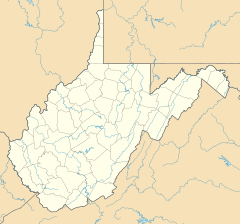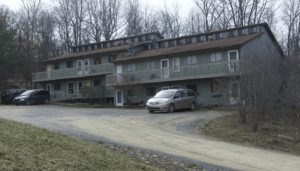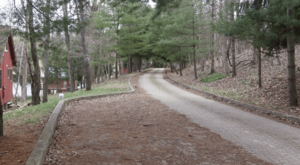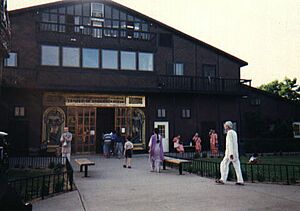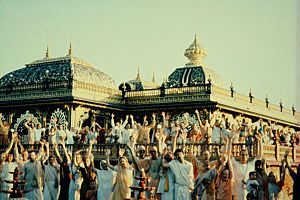New Vrindaban facts for kids
Quick facts for kids
ISKCON New Vrindaban
|
|
|---|---|

The Palace of Gold
|
|
| Country | United States |
| State | West Virginia |
| County | Marshall |
| Area | |
| • Total | 1.9 sq mi (4.8 km2) |
| • Land | 1.8 sq mi (4.7 km2) |
| • Water | 0.04 sq mi (0.1 km2) |
| Elevation | 1,175 ft (358 m) |
| Population
(2010)
|
|
| • Total | 352 |
| • Density | 189.9/sq mi (73.3/km2) |
| Time zone | UTC-5 (Eastern (EST)) |
| • Summer (DST) | UTC-4 (EDT) |
| ZIP codes |
26041
|
| Area code(s) | 304/681 |
| GNIS feature ID | 1717344 |
|
Prabhupada's Palace of Gold
|
|
| Location | Near Moundsville, West Virginia |
| Area | 50.1 acres (20.3 ha) |
| Built | 1973-1985 |
| NRHP reference No. | 100002852 |
| Added to NRHP | August 28, 2019 |
New Vrindaban is a special place in Marshall County, West Virginia, near Moundsville. It is an unincorporated area, which means it's not officially a city or town with its own government. It's also an ISKCON (or Hare Krishna) community.
This community was started in 1968. It was founded by Kirtanananda Swami, a follower of A.C. Bhaktivedanta Swami Prabhupada. Prabhupada was the person who started ISKCON. New Vrindaban is named after a holy city in India called Vrindavan. The area covers about 1,204 acres. It includes buildings, homes, and businesses. Two important places here are the Sri Sri Radha Vrindaban Chandra Temple and Prabhupada's Palace of Gold.
Contents
Exploring New Vrindaban's Location
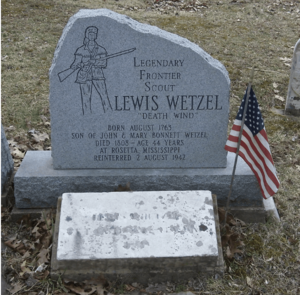
In 2010, about 352 people lived in New Vrindaban. It's bordered by Big Wheeling Creek to the north and Stull Run to the east. The village of Limestone is to the southwest. The community has its own water and sewer services. All the streets in New Vrindaban now have names.
Besides the ISKCON community, New Vrindaban is home to the McCreary Cemetery. This cemetery is where Lewis Wetzel, a famous West Virginia pioneer, is buried. You can also find local businesses and other ISKCON-related groups here. The main ways New Vrindaban makes money are from tourism, farming, and small home-based businesses.
A Look at New Vrindaban's History
The New Vrindaban community began in 1968. It was started by Kirtanananda Swami and Hayagriva Das. They were early students of A. C. Bhaktivedanta Swami Prabhupada. The community grew a lot under Kirtanananda Swami's guidance. By the mid-1970s, over 100 people lived there. In the 1980s, the population grew to more than 500.
ISKCON New Vrindaban follows a strict vegetarian diet. They believe that eating meat creates negative karma. Also, Alcoholic beverages are not allowed in the main holy areas around the Temple of Understanding Circle Drive.
On July 4, 1983, a statue of Sri Nathji was placed in the RVC Temple. In October 1986, a count showed 377 adults living in the community.
In 1987, the ISKCON Governing Body Commission made a decision about Kirtanananda. The New Vrindaban community was later separated from ISKCON. After Kirtanananda Swami left, new leaders took over. The community was welcomed back into ISKCON in 1998.
Discovering Prabhupada's Palace of Gold
The Palace of Gold was first planned in 1972. It was meant to be a home for A. C. Bhaktivedanta Swami Prabhupada. He was the founder of the International Society for Krishna Consciousness (ISKCON). After Prabhupada passed away in 1977, the plans changed. It became an amazing palace made of marble, gold, and carved teakwood. It was opened as a memorial shrine on September 2, 1979.
Kirtanananda Swami and Bhagavatananda das were key people in designing and building the palace. The materials for the palace cost about $600,000. However, the workers were volunteers from the community. They often learned building skills as they went along. Kirtanananda Swami said that as their spiritual awareness grew, so did their building skills and creativity.
When Prabhupada's Palace of Gold opened in 1979, many news outlets praised it. CBS PM Magazine said its beauty was "hard to exaggerate." Life magazine called it "a place where tourists can come and be amazed." The New York Times even called it "Heaven."
For a while in the early 1990s, the palace didn't get enough money for upkeep. But even so, about 50,000 tourists and Hindu pilgrims visited each year by 2008. Since 2011, a big project has been underway. It aims to restore and renew the palace. This project is expected to cost $4.27 million.
Images for kids
-
Statues of Chaitanya Mahaprabhu and Nityananda (Sri Sri Gaura Nitai) in June 2007.
-
Statue of A. C. Bhaktivedanta Swami Prabhupada in July 1997.


